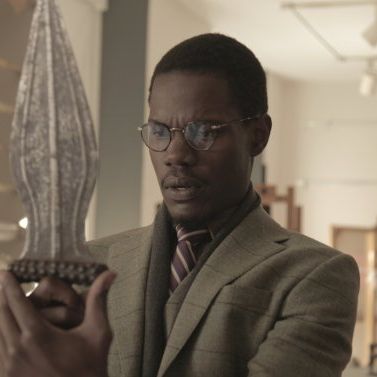
Spike Lee’s Da Sweet Blood of Jesus is the strangest movie he’s ever made. It may look on the surface like a no-budget doodle — Lee financed the film partly through Kickstarter and shot it in record time — but it’s a work of dramatic contrasts. Even its genesis feels oddly bifurcated: It’s a remake of the late playwright Bill Gunn’s 1973 black horror-exploitation-allegory classic Ganja & Hess — at times a surprisingly direct one — that nevertheless feels deeply personal. It’s a genre-bending mash-up, a non-vampire vampire movie about class, race, love, and cruelty. It consciously seeks to marry its diverse influences in an attempt to present something between schlock and art house, between passionate gore and urbane chill. It contains multitudes, and not always all that well.
The contrasts are right there in the opening credits, as young dancer Charles “Lil Buck” Riley slowly does his signature “Jookin” moves to classical music in a variety of open-air Brooklyn settings: a basketball court, the waterfront, an empty lot, etc. His dancing — a mix of contortionism, break dancing, and ballet – is elegant, surreal, and hypnotic. The sequence recalls the famous opening of Lee’s own Do the Right Thing, with its colorful shots of Rosie Perez furiously dancing to Public Enemy’s “Fight the Power.” It might also be the best thing in the entire movie; even though most of the film takes place on Martha’s Vineyard, the heady atmosphere of that opening lingers throughout for some time, curiously informing the erotic-demonic quasi-allegory at hand.
When we first see Dr. Hess Greene (Stephen Tyrone Williams), he’s sitting in the back row at the same church where Red Hook Summer’s troubled Da Good Bishop Enoch Rouse preached. Hess is not a religious man, however; he maintains an eerie, stony silence throughout the boisterous service. He is, in fact, a man of science (“God’s natural enemy”), an anthropologist researching African traditions and rituals, and he’s developed a fascination with Ashanti myth and folklore. Delicately handling a beautiful, mysterious Ashanti blade, he tells his research assistant Dr. Hightower (Elvis Nolasco) of how the Ashanti pioneered anesthesia, transfusions, and surgeries long before anyone else. Their conversation is stiff and academic, but the film soon gives way to genre histrionics when the troubled, possibly possessed Hightower stabs Hess with the Ashanti blade, then blows his own brains out. Hess miraculously wakes up from the attack as if nothing has happened and begins licking Hightower’s blood.
Lee swears that Da Sweet Blood is not a vampire movie, and it isn’t — in that these characters aren’t really vampires. They don’t sprout fangs, nor do they sleep in coffins and hide from the sunshine. Rather, he is interested in the allegorical possibilities of blood addiction, which is itself not a particularly original idea. (Quick, name a movie about vampires and blood that isn’t an allegory of some sort.) He’s also interested, as Gunn was, in portraying the duality of assimilation. Hess spends most of his time at his tony 40-acre (get it?) estate in Martha’s Vineyard, where he hobnobs with the rich and is escorted around in a Rolls Royce by his servant and chauffeur (Rami Malek), but he heads into the inner city when he needs to find his victims and harvest their blood.
Something approaching redemption comes for Hess with the arrival of Ganja (Zaraah Abrahams), Hightower’s ex-wife, who shows up looking for her old spouse. The two immediately strike up a surprisingly erotic romance. Though their behavior toward others is marked by classism and cruelty — he randomly preys on single mothers in the projects, she treats his servant like dirt — Ganja and Hess display a tenderness towards each other that feels real. It’s a respite from the stultifying, carefully circumscribed boundaries of their world. They seem to know something when they’re together that they forget when they’re apart.
This is also basically the plot of Ganja & Hess, but whereas Gunn’s film had a psychedelic, dreamlike expansiveness, Lee alternates his style between somnolent exchanges and unhinged, earthy wallows in gore and sex. It’s as if the conflict between aspiration and impulse has been absorbed into the very textures of the film. The effect is as fascinating as it is jarring. Da Sweet Blood of Jesus is a mess, but it’s the kind of mess only one of our greatest filmmakers could make.





